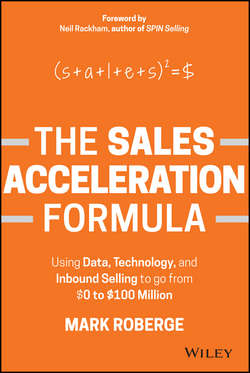The Sales Acceleration Formula

Реклама. ООО «ЛитРес», ИНН: 7719571260.
Оглавление
Roberge Mark. The Sales Acceleration Formula
Foreword
Acknowledgments
Introduction
Part I. The Sales Hiring Formula
1. Uncovering the Characteristics of a Successful Salesperson
2. Five Traits Great Salespeople Have and How to Interview for Them
Coachability
Curiosity
Prior Success
Intelligence
Work Ethic
3. Finding Top-Performing Salespeople
Build a Recruiting Agency within Your Company
Find Quality Passive Sales Candidates on LinkedIn
Find Quality Passive Sales Candidates through Your Team: The “Forced Referral”
Understand the Sales Talent Pool in Your Area
4. The Ideal First Sales Hire
Part II. The Sales Training Formula
5. Setting Up a Predictable Sales Training Program
Defining the Three Elements of the Sales Methodology: The Buyer Journey, Sales Process, and Qualifying Matrix
Create a Training Curriculum around the Sales Methodology
Adding Predictability to the Sales Training Formula
Constant Iteration on the Sales Process
6. Manufacturing Helpful Salespeople Your Buyers Trust
Train Your Salespeople to Experience the Day-to-Day Job of Potential Customers
Enable Your Salespeople to Build Their Personal Brand with Potential Customers Using Social Media
Part III. The Sales Management Formula
7. Metrics-Driven Sales Coaching
Implementing a Coaching Culture throughout the Organization
Creating the Coaching Plan Together with the Salesperson
Examples of Metrics-Driven Skill Diagnosis and Coaching Plans
“Peeling Back the Onion”
Measure the Coaching Success
8. Motivation through Sales Compensation Plans and Contests
Criteria to Evaluate a New Commission Plan
Involve the Sales Team in Compensation Plan Design
Promotion Tiers: Removing the Subjectivity from Promotions and Compensation Adjustments
Using Sales Contests to Motivate the Team
The Best Contest I Ever Ran
9. Developing Sales Leaders – Advantages of a “Promote from Within” Culture
Prerequisites for Leadership Consideration
From the Classroom to the Real World
Common Potholes from New Sales Managers
Part IV. The Demand Generation Formula
10. Flip the Demand Generation Formula – Get Buyers to Find You
How Can Your Business Rank at the Top of Google?
This Does Not Happen Overnight
Create a Content Production Process
Complement Content Production with Social Media Participation
Long-Tail Theory
11. Converting Inbound Interest into Revenue
Marketing's Role in Converting Interest into Revenue
Sales' Role in Converting Interest into Revenue
12. Aligning Sales and Marketing – The SMarketing SLA
The Marketing Service Level Agreement (SLA)
The Sales Service Level Agreement (SLA)
Part V. Technology and Experimentation
13. Technology to Sell Better, Faster
Accelerate Lead Sourcing with Technology
Accelerate Sales Prospecting with Technology
Accelerate Lead Engagement with Technology
Automated Reporting with Technology
14. Running Successful Sales Experiments
Generating Ideas for Experiments
Best Practices of Experiment Execution
15. HubSpot's Most Successful Sales Experiments
The HubSpot Value Added Reseller (VAR) Program
GPCT
16. Conclusion: Where Do We Go from Here?
All of the Proceeds of This Book Will Be Donated to BUILD-Boston
Index
Отрывок из книги
Sales doesn't get any exemption from the curse of living in interesting times. Everyone recognizes that today we face unprecedented challenges: the consequences of the Internet and e-commerce, the increasing power and sophistication of purchasing, the effects of globalization. There's no shortage of “interesting” challenges confronting sales organizations, sales managers, and their salespeople.
Now stir another nasty difficulty into the mix. Sales is suddenly in the strategic spotlight. Boardrooms across the world are looking more closely at sales strategy than ever before. What's driving this new interest? There are several reasons, but two factors stand out above the others. The first is the huge increase in competition. Today no niche is safe. There's an oft-quoted figure that the average company today has twice as many competitors as it had five years ago. Nobody knows how true this is, but many experts – myself included – believe it to be so. Assuming the figure is valid, that's another way to say that, statistically, the average company's market share has been cut in half. The second factor is the precariousness of the strategy that most companies have relied on to counter the effects of hypercompetition. Ask the average company to tell you its primary strategy for success in a competitive world. I did just that recently at a meeting of corporate strategists. More than 70 percent responded that their strategy was “innovation.” And, in response to my follow-up question, “Is it working?” more than half said that it was not.
.....
Finally, thanks to my wife, Robin, and my two boys, Kai and Zane, for providing the love, purpose, and motivation that drive me every day.
In Part I, I outline the Sales Hiring Formula. You will learn how to leverage metrics to predictably hire the same successful salesperson profile every time. You will learn that there is no universal mold for “the ideal sales hire.” The ideal sales hire depends on the company's buyer context. A top performer at one company may fail at another. However, the process to engineer the ideal hiring formula is the same for every company. Devising this formula early on in a company's development is critical to ensuring that the team hires only salespeople who have the highest probability of becoming top performers. As a practical example, I share the traits that were consistent across HubSpot's top sales performers, explain how I came to this conclusion, and describe how I consistently evaluated candidates on each trait.
.....